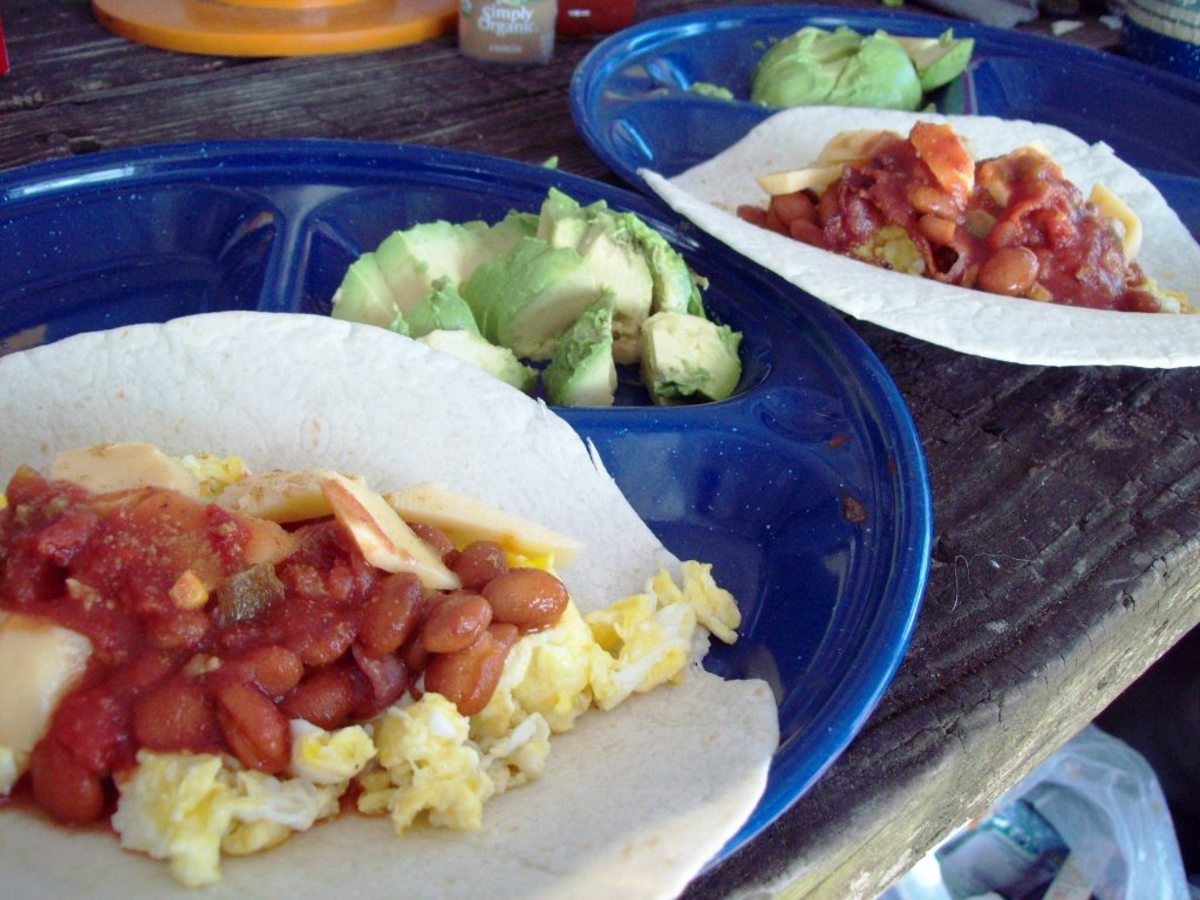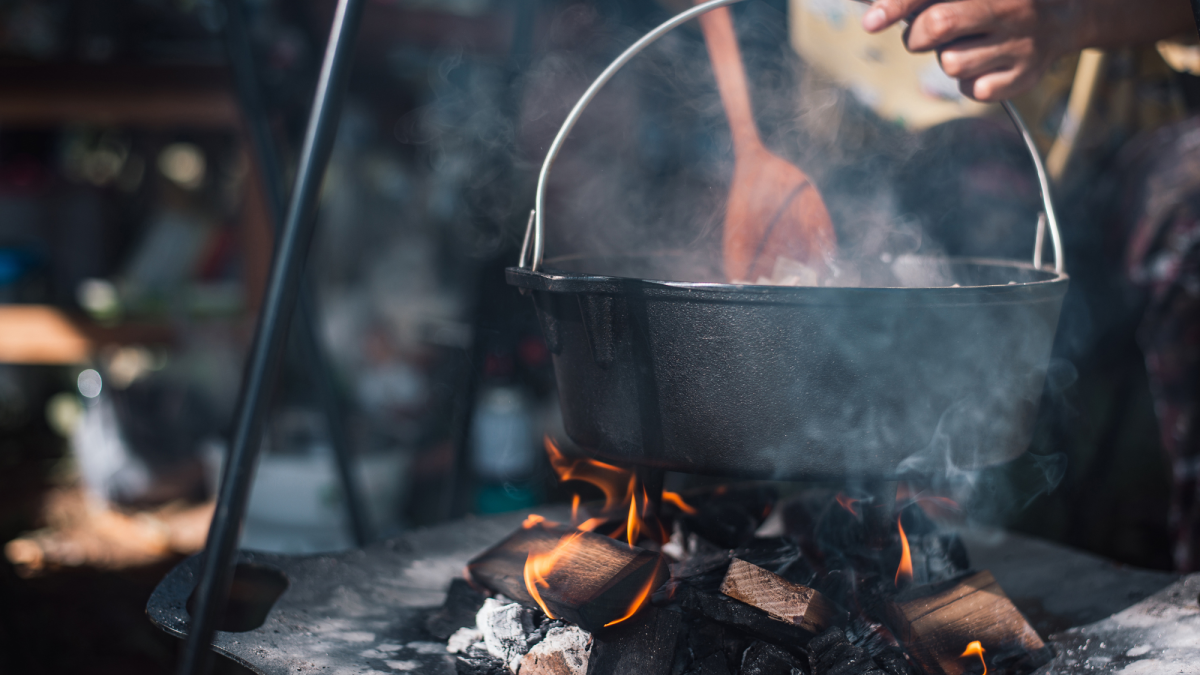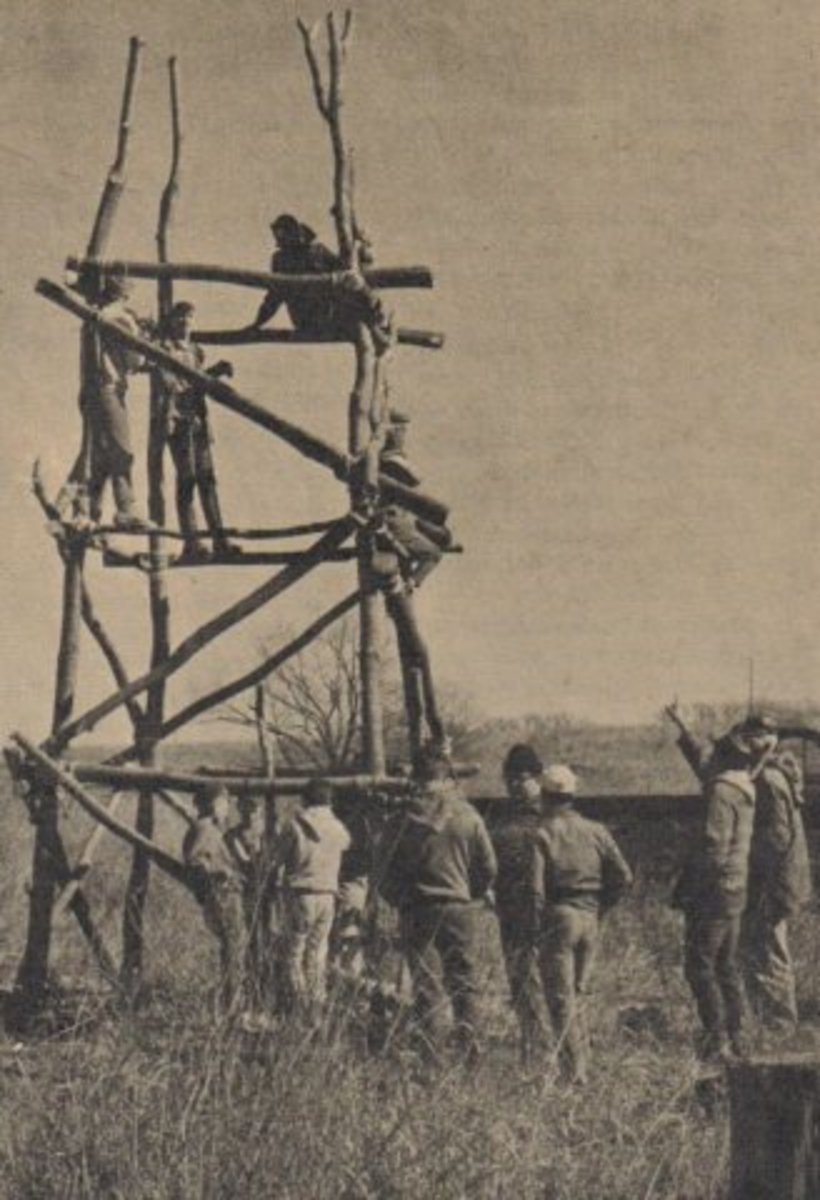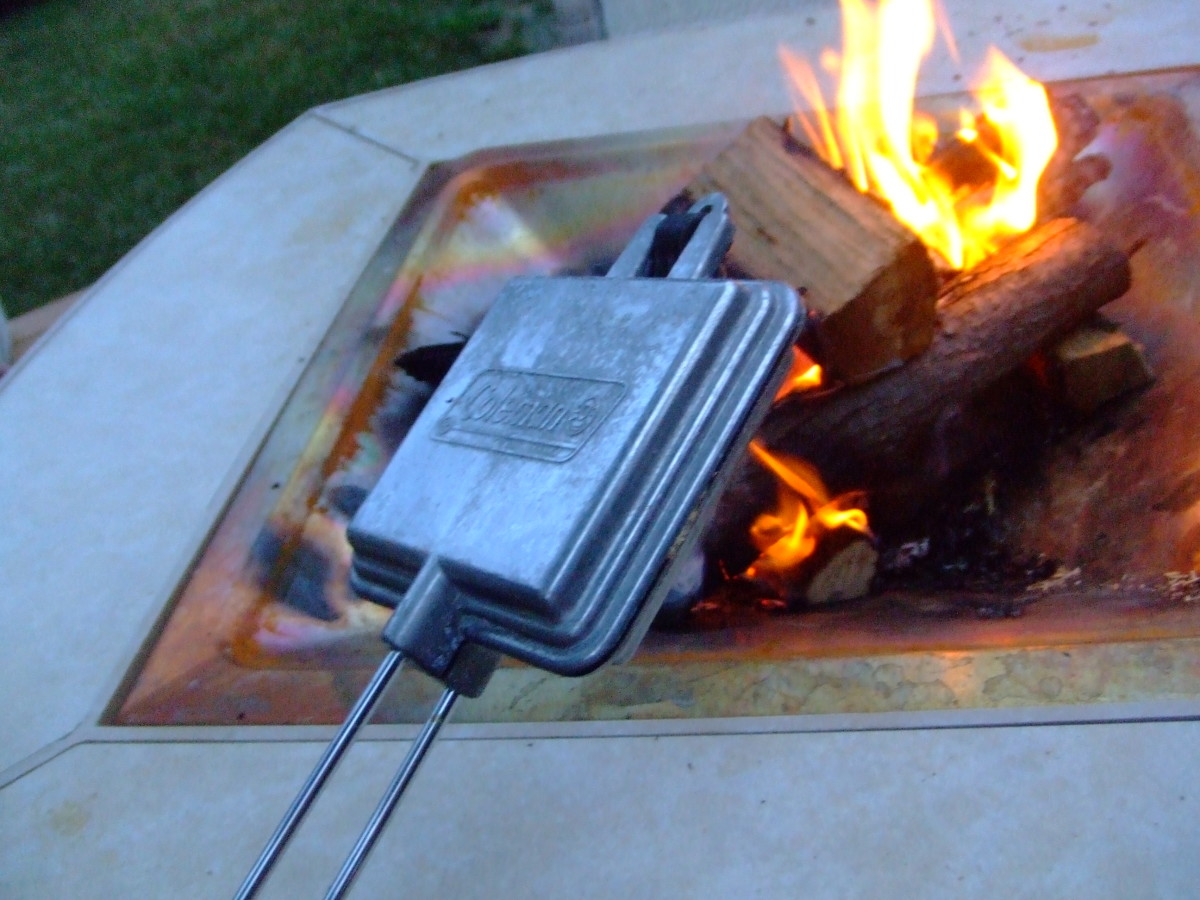Scout Camping Tips and Cooking Recipes
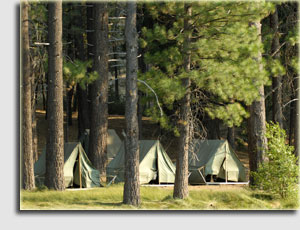
Ahhhhh! We've finally reached camp! On this trip we Boy Scouts will be car camping. This means that we won't have to tote everything we need on our backs. Instead, we are in an area where we have access to our vehicles which are loaded to the gills with provisions for our campout in the not-so-near wilderness. Woohoooo!
But first, I must digress. Over the past month, we, as responsible, organized Scouts have prepared ourselves for our campout by planning a proper menu and have collectively decided on what foods we will need for the meals that we will choose--Scouts--pleeeease remember the Basic Four-- (and don't forget the condiments)!
An estimated food cost is projected and that amount divided between the number of campers going, and a Scout 'grocer' as it were, is chosen. At the meeting prior to the campout, each Scout is expected to bring in his share of money to purchase the groceries. The Scout Grocer is responsible for assuring that all necessary items have been purchased for the menus to be carried out. It is at the discretion of the grocer to substitute an item should it--and (if you want to keep the peace) only if -- the item is not available. A few days prior to the campout, the grocer will make one last call to the members of his Patrol to ensure the number of attending Scouts before purchasing the food (there is always a chance that someone must cancel at the last minute). The cost for the food is tallied and divided among the amount of those participating in the campout. The night before campout, the grocer notifies the Scouts of their share of grocery costs which are to be brought with them on the day of departure; any leftover monies go to the grocer for services (don't worry, Mom's always get the monetary raw end of the deal; I think it's a requirement) ha ha. On top of the cost of food, Leaders will also have already estimated the travel cost in gas; this cost will be split among both Scouts and Leaders alike (it's usually about $5 or so). Upon the day of campout, the patrol members will immediately settle their portion of cost with the Scout grocer and give their portion of gas money to the respective leader.
We have set up our kitchen with fully loaded grub boxes--what? We don't have that in our grub box? Hmmmm...someone wasn't doing their job...well, we will help him out the next time. For right now, we will have to borrow from our neighboring Patrol Leader. **NOTE: At next meeting, you (the Patrol) will have to replace or return what was borrowed and recoup whatever was lent.
What's in the grub box? The grub box consists of basic kitchen items that you will need to make cooking life easier. Post a permanent list of items within the box in order to keep stock of any missing items: tin foil, plastic wrap, ziplock bags, sugar, tea bags, a small bottle of cooking oil, spices and condiments, can opener, mixing bowls, pots and pans, measuring cups & spoons, serving & eating utensils, a roll of paper towels, cups and plates (uhhh, guys--please remember that hot foods DO melt styrofoam plates!). There must be a dishpan, a scrubby pad, a dish cloth and towel (please wash them once in awhile); and since we are Scouts who strive to preserve the wilderness, we try our utmost to use organic dish detergent. Don't forget baby wipes; a Scout's best friend and can be used for a multitude of things. There should always be some rope line on which to hang those wet towels, as well as black trash bags to haul out whatever trash we make and pick up along the wood and water trails. And lastly, each Patrol grub box should have potholders, matches, one gas stove and always, always, at least one extra can of propane.--Why? Wellll, there's nothing worse than the last drop of propane giving out right in the middle of cooking your food--especially in bad weather. To prevent bugs, keeping food with sugars should not be left in the grub box between campouts unless it's in an air-tight container that keeps well closed (such as Tupperware). When making your menu, think about the ingredients carefully; ingredients left out could be a disaster--and it affects the entire patrol. Depending on the preference of the Patrol, adding other food items to keep in the box should be discussed within the Patrol. ALWAYS check your grub box at time of menu planning so that anything that is needed, needs to be replaced or replenished (such as oil) may be purchased at time of buying groceries.
Ok, this is for all you parents and leaders out there: Have you helped your Scout to prepare his backpack and the foods that are going into it? As a Leader, is tonight the night that you are preparing the Leaders' meal? Is tonight your Scout's responsibility to prepare the Patrol food?
Let me stress that much of the Leader's main responsibility, as well as the Scout parent, is to guide--the boys of an established Troop are actually to teach one another. With guidance from the Leaders, it is the responsibility of the older Scouts to teach the younger Scouts the ins and outs of Scout life and the skills that they will need--skills that they will carry with them for the rest of their lives! Without Scout-to Scout leadership, it is much harder for the younger Scouts to relate, thus their teamwork is less cohesive. By allowing them to teach one another, they will also learn both good and bad mistakes through trial and error; mistakes that many older boys have already experienced--and mistakes that every Scout will have to experience on their own to complete their learning experience; Afterward, they'll all have a good laugh as they recall, "remember when...?"
Parents: oversee, but don't get histerical. If he wants to carry that 2lb jar, LET HIM! I guarantee he won't do it the next time! And DON'T pack for him; he'll learn to pack earlier and wisely--especially when he took it upon himself to not layer is clothing. Don't nag!
Leaders: you all too, are to set an example taking turns as cook & bottle washer; plan your menus in the same manner. Sometimes its fun to compete with the Scout menus as you sit at your own table stuffing your face, thinking how much better you cook..Ha! Not hardly; don't be so smug; you'd be surprised! Leftovers? With Scouts? Not a chance!
Are we there yet? Are we there yet?
Leaders...please--oversee the plans that each Patrol has made and help the Scouts in your care choose their menus a little more wisely--a little less Pop Tarts and cereal, and more cooking creativity; they can't learn to do some honest cooking if it's ready-made, nor will their foods be as nutritous; car camping gives them that experience and the opportunity to experiment with food. Here are some tips for both Leader and Scout -- "Be Prepared!"
To avoid any confusion or problems, each Scout should already be aware of his job before setting foot at the campsite (i.e. collector of firewood, cook, dishwasher). If not, he is to consult the Patrol Leader; this, by any means, does not mean that they don't readily volunteer to help somewhere or someone when there is work to be done. Scouting is about leadership, organization and teamwork.
Are we hungry yet? I'm starving! Start the fire and haul out the marshmallows!
Save time on camp cooking with a little organization. Use a Zip Lock bag and pre-prepare a meal by putting in all the dry ingredients of a recipe in their proper proportions and label the bag with the other necessary items required to complete the meal (such as eggs, oil...), then label the meal (i.e. Pear Cobbler). This system not only makes packing lighter but also helps simplify cooking ingredients at mealtime. Iinclude the recipe card; it may want to be used by this patrol or another, again.
As stated earlier, breakfast menus should never consist of Pop Tarts and chocolate bars! Talk about this at meetings. If you want to develop good skills, first develop good eating skills; this not only makes for a hearty meal, but this will last our children their entire life, not just when sitting around a campfire! Creativity starts in the kitchen, and a Scout eats what he makes...(and you'd be surprised...sometimes it can be prrrrrrettttttttty interesting)!
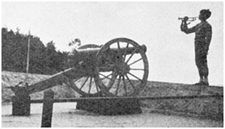
Ahhhh, the morning reveille--haven't you gotten that fire started yet?
The following recipes have been tried and true for far more than my 25 years in Scouting, i'm sure, and so from our campfire to yours, continue to be creative with these and other recipes, eat heartily, eat hardy and enjoy!
The biggest error in cooking is not allowing enough time. Scouts--in-between campouts, familiarize yourself with some of the recipes that you might like to make on your campouts, Ask an adult to help show you how to prepare for, and prepare the meal. Not only will this give you an estimated time frame that you will need once you're out at camp, but it will also help you have a little more confidence in your cooking abilities. Even so, leave yourself another 10-15 minutes extra guestimated time. There's always welcome room for more breathing time!
Scrambled Eggs, Sausage and Apples: 5 Ingredients: spaghetti pot, water, 1 lrg pkg, mild sausages, 1 pkg brown sugar, 2-3 sliced apples (paring is optional). Shake sliced apples in a Zip Lock bag full of brown sugar to coat well and set aside. Boil water with just enough water to cover the apples. Meanwhile brown the sausage in a skillet until almost done. When apples are soft, add sausages to the pot until completely cooked--it won't take long--(there should be NO pink in the middle). Use the sausage grease in the skillet to cook the eggs. Add enough brown sugar, to make a thick, glaze coating on the apples and sausage and mix together well. Compliment with pancakes or biscuits baked in Dutch oven, and top with fruit (even blueberries or blackberries from the trail). Don't forget juice, water, cocoa or tea. Enjoy!
Dutch Oven Breakfast: 2 Eggs, 1/2C milk, 1/4C oil, 4C Bisquick, pkg cheddar cheese, pkg colby cheese, pkg pepper jack cheese, 1 lrg green pepper, 1 lrg onion, 2 sm tomatoes, 16oz pkg sliced ham (diced), lrg pkg of breakfast sausages (or pkg of 4 lrg sausages), bacon bits. Mix eggs, milk, oil and Bisquick well. Shred all cheeses, dice pepper, onions and tomatoes and cut sausage into bite-size pieces. Having coated Dutch oven and lid with Crisco, heat covered oven over coals until hot. Pour 1/2 of the Bisquick mix into oven then add and 1/2 of the cheeses, meats & veggies, alternating each, ending with the Bisquick mix and cover with lid. Place several hot coals on top of lid. Check within 5 min. Once Bisquick starts to set, alternate the other half of the meat, cheese and veggie mix and top with remaining Bisquick mix; replace lid with coals. Continue to check on meal to prevent burning until Biscuick is lightly browned. Yyyyyyummmmy!
Chicken and Rice: This isn't your ordinary dinner! Dutch oven, Crisco shortening, 4 chicken breasts, 2C rice, 4C water, 1 lrg onion, can mushroom soup. Oil dutch oven well with Crisco. Pour water in oven; when boiling, pour in rice and settle with fork; close lid for 10 minutes. Add raw chicken and sliced onions, top with mushroom soup and cover (place hot coals on top of lid) for 10 minutes or until chicken and rice are cooked. This is a very tender meal; I don't know of any Scout who doesn't like this! Add vegetables and/or other meats if you like.
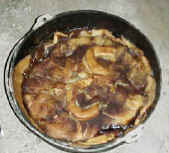
Pear Cobbler: (Prep time: 45mins.) Dutch oven, aluminum foil, (2) 29oz can of sliced pears, 1C sugar, 1 1/2 tsp cinnamon, shortening, 3C Bisquick, 2 eggs, 1/2C milk,1C milk. Line dutch oven with foil and place oven over coals with coals on lid. When oven is hot, put pears in with no more than 1/2 cup of the juice (save the rest). Sprinkle 1 C of sugar and 1 1/2 tsp cinnamon on fruit. Put lid back on with coals on top. Thoroughly mix: 3C biscuit mix, 2 eggs, 6 Tbsp melted shortening and 1C milk in bowl. Remove oven lid and drop dough one spoonful at a time onto the top of fruit. DO THIS QUICKLY TO RETAIN HEAT IN DUTCH OVEN. Don't spread dough around or smooth dough out. Return lid with coals (about 400 degrees). Check in 5 min. If crust has started to form, the fire is too hot; there should be no visible change in the dough surface. Check in 10 min; a very light crust should be starting to form; add more coals if crust is not forming, If there is a hard crust or some browning, remove coals to reduce heat. Check in 20 min. Dough should now be a light brown; if it is a dark brown, remove most of the coals from lid. If there is no browning, add more coals to the lid. Cobbler should be done in about 30 minutes. Don't burn this; test by pushing a piece of clean straw or a wood splinter into the dough; if comes out dry or with dry crumbs, it's done. Remove oven from fire and allow to cool before serving. Ohhhh, you're going to love this! Experiment with other canned or fresh fruits next time. (when using fresh fruit, you'll need 6-8C of sliced fruit or berries and at least 2C of sugar and add water in place of the canned juice).
- Fireplace and Chimney Supplies : Home Gas logs, Fireplace screens, chimney caps : Home
Fireplace tools, Gas logs, Chimney caps, Top-sealing dampers, Fireplace screens, stainless steel chimney caps, and copper chimney caps.


